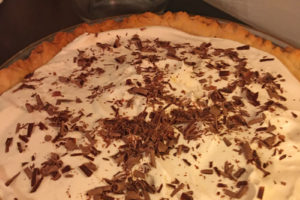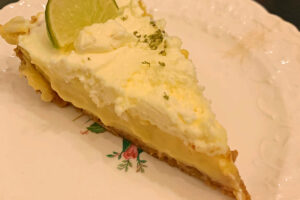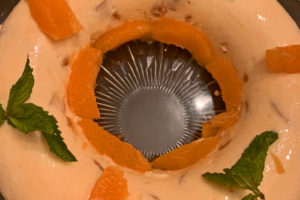Coconut Cream Pie with a mountainous meringue topping was a staple in the 1950s Midwest. Though you don’t see it much any more, it is a delectable dessert and always a favorite with your guests.
Many shortcuts can be taken for Coconut Cream Pie: a ready-made crust, a package of vanilla pudding for the filling, or even, God-forbid, Cool Whip. However, none of these hacks can hold a candle to the real thing. And it’s not all that difficult to make, especially if you do it in stages.
The Crust
I like to use a food processor for this, which takes a little additional shortening to achieve a good result. This recipe can easily be adapted to the handmade version.
I find for both taste and flaky texture that a combination of butter and lard is best. If the idea of lard turns your stomach, substitute vegetable shortening or use all butter.
Process the flour and salt for a minute to combine. Add the butter and lard, cut into pieces, to the flour mixture.

Adding shortening to the flour.
Pulse several times until coarse-crumb consistency is achieved.

Coarse-crumb mixture
With the processor running, add just enough ice water, a tablespoon at a time, to bring the mixture into a ball.

Just enough water to form a ball.
Briefly knead the ball into a circular disk. Wrap and refrigerate it for several hours, or better, overnight.

Wrap in plastic and refrigerate.
Preheat the oven to 450 degrees and roll the dough out from the center, large enough to cover your pie plate.

Rolling out the dough.
Roll the dough around your rolling pin.

Roll dough around rolling pin.
Unroll the dough into the pie plate. Trim the edges and prick all over with a fork.

Prick pastry all over.
Bake for 12-15 minutes until the crust is golden. Cool on a rack.

Bake until golden.
The Filling
For my custard, I like to use a mixture of cornstarch and flour for a velvety consistency and for insurance that the custard will thicken sufficiently. In the top of a double boiler, whisk together the sugar, cornstarch, flour, and salt.

Whisk milk into dry ingredients.
Gradually whisk in cold milk and place over boiling water, stirring constantly for 8-12 minutes until the mixture thickens. Cover and continue to cook undisturbed for about 10 more minutes. In the meantime, beat the egg yolks in a separate bowl. Gradually stir one cup of the starch mixture into the egg yolks, then return the mixture to the pan and cook for 2 minutes, whisking gently.

Add egg yolks to hot mixture.
Remove from the heat. Add the butter and vanilla, stirring gently.

Stir in butter and vanilla.
For the shredded coconut you can use either sweetened or unsweetened. (I use sweetened simply because I find it’s softer and moister.) Gently stir in the coconut and then stir from time to time to prevent a skin from forming.

Add coconut.
When the custard is nearly cool, pour it into the baked pie shell and chill.

Pour custard into pie shell.
The Meringue
I prefer an Italian meringue to ordinary meringue for several reasons: it gives a better texture and holds up for a longer period of time; it requires less baking; and it’s an insurance against salmonella, which is possible with ordinary meringue if not baked long enough. Feel free to use ordinary meringue if you prefer.
Combine sugar and water in a small saucepan, stirring thoroughly to moisten the sugar. Place over medium heat. Begin beating the egg whites in a stand mixer, adding a pinch of cream of tartar when they begin to foam. Continue to beat.
At the same time, bring the sugar mixture to a boil over medium heat. Continue boiling, washing down any sugar crystals that form on the side of the pan with a moistened pastry brush.

Wash down sugar crystals.
Continue to cook until the sugar reaches the high end of the firm-ball stage, about 248 degrees. The goal is for the sugar mixture to be ready when the egg whites are for fully beaten.

Boil to firm-ball stage.
When the egg whites have formed stiff peaks, gradually pour the hot syrup into the egg whites in a steady stream, while continuing to beat at high speed. Be carefull that the boiling syrup doesn’t splatter on you as you add it.

Add hot syrup to beaten egg whites.
Once all the syrup has been added, continue beating until the meringue is smooth and shiny. Beat in the vanilla.
Spread the meringue over the pie filling and gently top with the remaining coconut.

Spreading meringue and coconut.
Place the pie in the middle of a 325 degree oven just until the top is lightly browned. Cool before serving.

Toasted coconut.

Cut Coconut Cream Pie.




